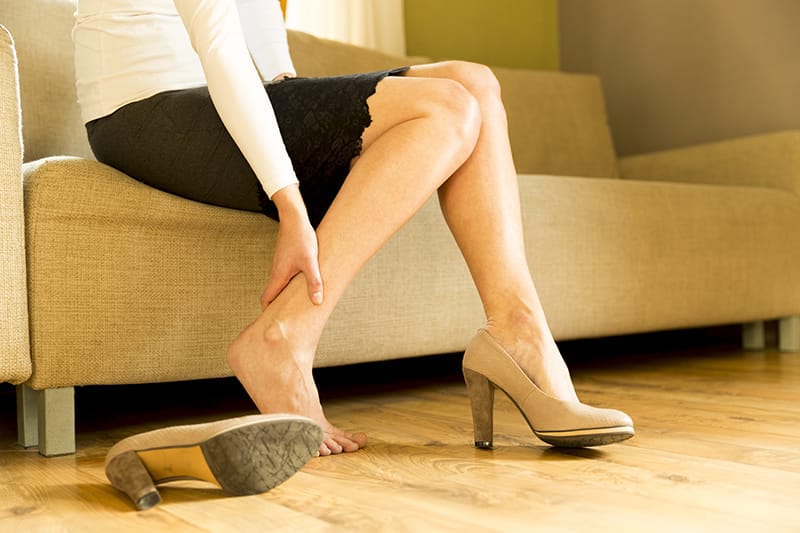You might not want to sit down for this.
Sitting for too long can lead to varicose veins or make the condition worse. Standing, too.
So don’t just stand there. Get moving! Because that’s the key to relieving your varicose vein pain and stopping them from showing up in the first place. In addition, when it comes to your vein health, it’s always a good idea to seek out an expert opinion.
Sitting and standing? How can they both lead to varicose veins?
It’s all about circulation. Your arteries deliver blood from the heart to the rest of your body. Your veins send it back, but they have help. Valves in the veins prevent blood from flowing in the wrong direction. Muscles act like pumps, squeezing the veins and giving the blood a push on its journey back to the heart.
You don’t need an anatomy class to know your legs are below your heart. So the blood has to fight gravity to travel up through the veins. When you’re standing, it’s also facing extra pressure from your legs carrying the weight of your body. Because your muscles only pump when they move, standing or sitting still takes away your veins’ biggest helper.
Against all these obstacles, your blood struggles to make the trip up north. Over time, the added pressure damages your valves. Suddenly, your veins are no longer a one-way street. Blood pools up in your legs, turning your veins into engorged cords bursting from your skin. The more sitting and standing you do, the worse these varicose veins get. In addition to cosmetic issues, you can experience itching, burning, discomfort and pain in your veins and legs.
I can’t lay around all day. What can I do prevent varicose veins?
You wouldn’t want to take this lying down anyway. Yes, getting horizontal eliminates the fight against gravity and your body weight. Elevating your foot at night — only three or four inches — by placing a pillow or folded blanket under your mattress helps a lot. But at other times, elevation still puts your muscles on the sidelines and makes your veins do all the work.
You want to move as much as possible. It’s good for your veins and good for your overall health. Exercise is the single best way to prevent and maintain varicose veins. Not an hour of activity at the beginning or end of the day though. While that physical activity is good for you, it isn’t enough. You’re still sitting or standing in place every other hour of the day. You need to break up those long spells of complacency to avoid problems.
4 Ways to Sneak in a Workout at Work
You’re too busy. You’re in a groove. You’re in a meeting. There are a hundred reasons it’s hard to be active at work. But while you’re hard at work, your veins are, too. And they need a break every 30 minutes or so. Give them relief by sprinkling these little workouts throughout your day:
- Walking — Take the stairs. Park further away. Hold a walking meeting. Ask a question on-the-go instead of over chat or email. There are many ways to work some walking into your day to keep your legs moving. Make a habit of them all!
- Toe raises — Raise up on on the balls of your feet. Lower yourself back down. Repeat again and again. Toe raises strengthen your calves, which act as the pump for the veins in your lower legs. This is an easy, unnoticeable exercise you can do while standing at your desk or waiting for a meeting to begin.
- Yoga — Strike a tree pose. Do a desk plank. Put ankle to knee. Find simple yoga moves you can do at your desk to keep your blood moving. Chair yoga is a gentle style developed specifically for people who need to stretch from a chair or supported by one.
- Biking — Or at least pretending to. Pedal your feet under your desk. Go forward and backward to loosen up your legs. You can even buy special under-the-desk pedals to mimic the real thing.
You don’t have to spend a long time exercising. Just a minute or two to get your blood flowing will do. If you have trouble working even these simple workouts in, try flexing your thigh and calf muscles for a more manual pumping. Or raising your knees and wiggling your toes to increase blood flow.
Keep on Moving Toward Better Vein Health
Regular exercise can help prevent varicose veins from forming and relieve the pain, itching and other symptoms that appear with them. When a little movement isn’t enough, or you’re more worried about the appearance of your legs, reach out to a vein specialist for the latest techniques and treatments for managing varicose veins.
